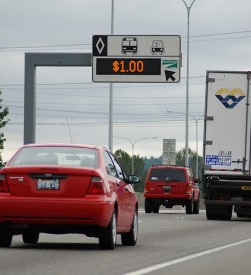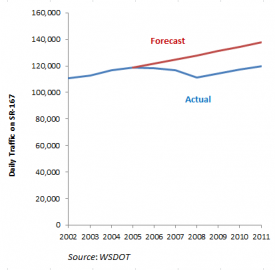
How much are people actually willing to pay to avoid being stuck in rush-hour traffic? Data from a Washington Department of Transportation pilot project offers some tantalizing clues—and suggests that drivers are a lot less willing to pay to avoid congestion than many experts think.
In fact, the evidence suggests that the large majority of motorists—including many well-off ones—opt to sit in traffic rather than pay a modest toll for speedier and more reliable travel. The implications are huge, and raise serious questions about how our transportation agencies plan and justify road projects.
The evidence comes from Washington State Route 167, just south of Seattle, where WSDOT operates the Pacific Northwest’s only “High Occupancy /Toll” (or “HOT”) lanes. Carpools, vanpools, and buses can always get into the HOT lanes for free. But solo drivers can use the HOT lanes too—provided that they’re willing to pay a toll. A computer adjusts the tolls in real-time to keep traffic flowing: when HOT lane traffic starts getting too heavy, the computer boosts the tolls, which discourages additional drivers from entering the HOT lane and bogging down traffic. In effect, the HOT lane serves as an “escape valve” for congestion—both by drawing some vehicles out of the general lanes, and by giving toll-paying drivers a quicker, more reliable trip.
But in addition to easing congestion, the SR-167 HOT lanes serve another important function: they provide solid data on how much drivers are willing to pay to avoid traffic delays. Drivers who can’t stand rush hour congestion will hop in the free-flowing HOT lane—and the toll rate at that moment, coupled with the time saved by traveling in the HOT lanes rather than the general lanes, reveals how much people are willing to pay to save time during rush hour.
 So far, the HOT lanes have attracted far fewer toll-payers, and much less revenue, than the early forecasts had predicted. During the first year of operation, the HOT lane tolls collected just $316,600—over half a million dollars shy of the projections (pdf, see Exhibit 11 on p. 15) that were made before the HOT lanes were opened. By the end of 2011 the gap between the projections and reality had exceeded $1.4 million, with toll revenues more than 60 percent below the early forecasts. (Click on the chart to the left for details.)
So far, the HOT lanes have attracted far fewer toll-payers, and much less revenue, than the early forecasts had predicted. During the first year of operation, the HOT lane tolls collected just $316,600—over half a million dollars shy of the projections (pdf, see Exhibit 11 on p. 15) that were made before the HOT lanes were opened. By the end of 2011 the gap between the projections and reality had exceeded $1.4 million, with toll revenues more than 60 percent below the early forecasts. (Click on the chart to the left for details.)
So why were those projections so over-optimistic about the HOT lanes’ appeal? It isn’t because the HOT lanes haven’t been working. In fact, according to WSDOT, the HOT lanes consistently offer a faster, more reliable commute than the regular lanes. The HOT lanes are working pretty much as advertised.
Instead, we suspect that there are two reasons for the unduly rosy forecasts. First, the early projections overestimated how quickly traffic would grow over time. Second, planners may have overestimated how much drivers are actually willing to pay for a quicker trip.
Let’s run the numbers, shall we?
 The first problem—overestimated traffic growth—is easy to spot. The state’s 2006 traffic and toll revenue study assumed that traffic volumes on SR 167 would grow at about 2.5 percent per year. But as WSDOT data shows, traffic volumes on SR 167 fell for three consecutive years, starting in 2006—including a drop of almost 5 percent in 2008, when gas prices spiked and the economy cratered. Traffic volumes have picked up since then, but are still well behind forecasts. With far fewer cars than anticipated, there’s been less congestion than predicted—and, as a result, less incentive for solo drivers to pay to use the HOT lanes.
The first problem—overestimated traffic growth—is easy to spot. The state’s 2006 traffic and toll revenue study assumed that traffic volumes on SR 167 would grow at about 2.5 percent per year. But as WSDOT data shows, traffic volumes on SR 167 fell for three consecutive years, starting in 2006—including a drop of almost 5 percent in 2008, when gas prices spiked and the economy cratered. Traffic volumes have picked up since then, but are still well behind forecasts. With far fewer cars than anticipated, there’s been less congestion than predicted—and, as a result, less incentive for solo drivers to pay to use the HOT lanes.
The second problem—how much drivers are willing to pay to save time—requires some deeper analysis.
According to WSDOT figures for 2011, northbound drivers during peak morning hours paid an average toll of $1.75 to enter the HOT lane, saving about nine minutes in the process. Southbound evening peak-hour travelers paid $1.25 for about six minutes of time savings. Given those values, peak hour HOT lane toll payers apparently are willing to spend about $12 for every hour they save in traffic.
Yet only a small fraction of peak hour drivers (13 percent in the morning, 6 percent in the afternoon) are paying to use the HOT lanes. So for solo drivers during peak hours on SR-167, the median value of travel time savings—the point at which half the drivers would pay more, and half would pay less—is by definition below $12 per hour. In fact, considering how few drivers use the HOT lanes, the median value of travel time savings could be far less than $12 per hour.
Traffic theorists believe that North American commuters are willing to pay at least half their hourly wage to avoid being stuck in rush-hour traffic. (See Todd Litman’s excellent literature review for more details of travel time valuation.) If that’s really correct, then with travel time savings valued at $12 per hour, commuters who earn about $48,000 per year ($24 dollars per hour, for 2,000 hours per year) should be willing to hop in the HOT lanes to save some time.
So the fact that so few drivers use HOT lanes during rush hour suggests two possibilities:
- Only a tiny fraction of SR-167 drivers earn $48,000 per year or more, or
- Peak-hour SR-167 drivers aren’t willing to pay half their hourly income to save time in the HOT lanes.
The first possibility seems unlikely. Data from the Census and WSDOT suggests, quite clearly, that plenty of SR-167 drivers earn more than $48,000 per year, yet aren’t hopping in the HOT lanes during rush hour! The SR-167 “travelshed,” as defined by WSDOT, actually has a higher share of higher-income residents than the state as a whole. (See method notes at the end of this post for more details.)
So that leaves us with the second possibility—namely, that in the one place in the Pacific Northwest where drivers are offered a choice to pay out of pocket for a quicker trip, they’re simply not willing to pay very much. Most drivers, even those from high-income households, would simply prefer to sit in traffic, rather than pay for a little speed.
The implications could be huge. Transportation planners typically justify big urban road projects based on drivers’ economic interest in saving time. The projects are costly, and the time savings may be illusory; but that’s how big roads are sold to the public. Yet if drivers themselves aren’t willing to pay much for quicker trips, shouldn’t we expect WSDOT to reconsider how much it should be investing in wider roads?
Method Notes
High-income drivers opting out of the HOT lanes. At the northernmost point of the northbound HOT lane, the average per-lane general purpose lane volume for the morning peak-hour is 1,143, or 2,286 trips in both lanes. At the same time, 1,008 cars moved through the HOT lane, only 420 of which paid the toll. Assuming that all the GP lane traffic is solo drivers, then, there are 2,706 peak-hour solo drivers each morning.
Within the SR-167 “travelshed” (as defined by WSDOT – pdf, see pages 2-3 – 2-5), data from the US Census shows that about half of all households have total incomes above $60,000 per year—with 23 percent of households earning more than $100,000 per year.
If SOV drivers reflect the same Census demographics of the travelshed established by WSDOT, than 622 (2,706 * 23%) come from households earning at least $100,000 per year. However, according to a survey fielded by WSDOT, 45 percent of tolled HOT lane drivers come from households in this income bracket. So that translates to 189 (420 * 45%) drivers from households earning at least $100,000 per year during the peak-hour northbound commute. With 189 high-income SOV travelers out of an expected 622, roughly 70 percent are opting out of the HOT lanes.
In short, real-world experience suggests that less than one-third of drivers from high-income households are willing to pay $12 per hour for a quicker trip during rush hour.
Our estimates are rough, and there are confounders. Not everyone on the road during rush hour is a commuter (and traffic theorists say that non-commuters pay as little as one-quarter of their hourly wage to save time). On the other hand, solo drivers tend to be better-off than average—simply because poorer folks drive less. To complicate things still further, some drivers may be uncertain about potential time savings: WSDOT posts toll rates at the entry points to the HOT lanes, but not how much time toll-payers can save. These factors add uncertainty to any analysis—so there’s no precise data to tell us the actual hourly earnings of the folks on SR-167, or what share of their income they’ll pay to avoid congestion.
Sources:
WSDOT 5-Minute Traffic Data Archive, SR 167 2008 – 2011, mileposts 24.61 northbound and 20.68 southbound.
WSDOT SR 167 HOT Lanes Pilot Project, Third Annual Performance Summary, May 2008 – April 2011 (PDF)
US Census American Community Survey 2006 – 2010, Table DP03, 5-year estimates, applied to Census tracts in the SR 167 travelshed identified by WSDOT in “SR 167 HOT Lanes: Social, Economic, and Environmental Justice Report,” 2007, 2-3 – 2-5. (PDF)


Comments are closed.